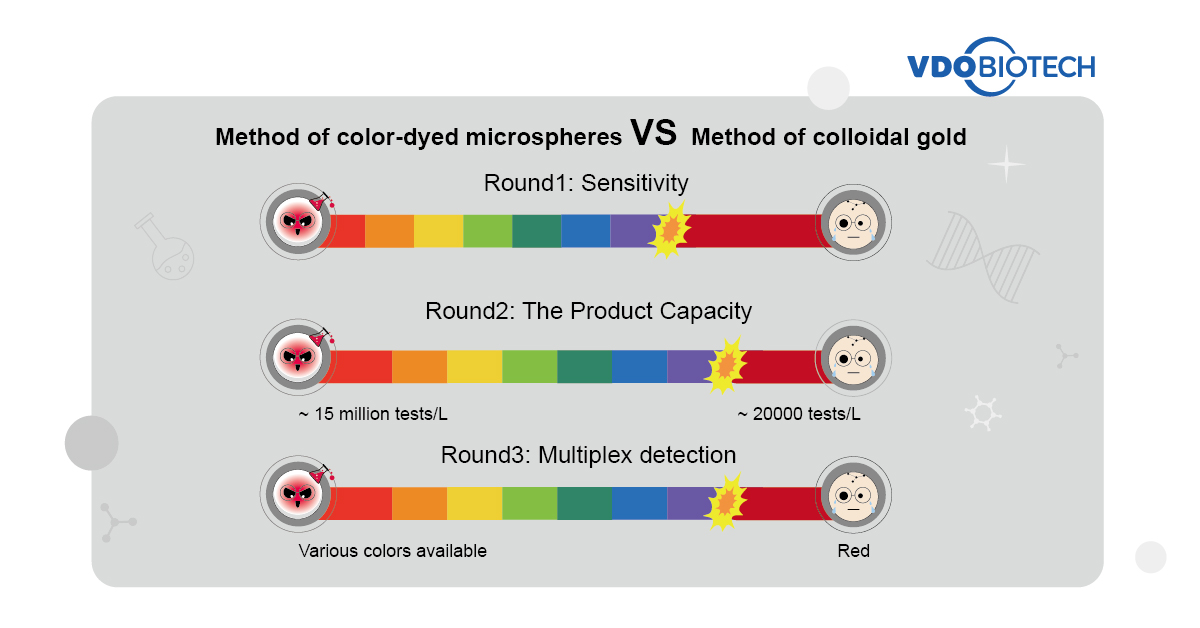A lateral flow test (LFT),[1] also known as a lateral flow device (LFD), lateral flow immunochromatographic assay, or rapid test, is a simple device intended to detect the presence of a target substance in a liquid sample without the need for specialized and costly equipment. LFTs are widely used in medical diagnostics in the home, at the point of care, and in the laboratory. These tests are simple and economical and generally show results in around five to thirty minutes.[2] LFT has also been widely used in COVID-19 rapid antigen detection in many countries, which can quickly give users a result within 5–30 minutes.
Improving the sensitivity, quantitative detection and multiplex detection are the three major directions of the development of LFT, especially the sensitivity is the key factor for LFT development. However, the above important factors are all affected by immunochromatographic markers. In immunochromatographic diagnostic reagents, ideal markers should have the following advantages.
High sensitivity, ng level, even pg and fg level
Has no effect on the immune activity, affinity and specificity of antibodies or antigens, and does not reduce the immune response signals
Uniformity, easy to prepare
Suitable for stable storage, reducing inter-batch and intra-batch differences.
Insensitivity to environmental factors
Safety
Easy to obtain ideal results and good repeatability
Colloidal gold is a commonly used marker in commercial LFT reagents. Colloidal gold has the advantages of convenient preparation, good stability, and easy labeling. However, its application is limited due to its single color, low sensitivity, inability to covalently cross-link, and narrow quantitative range, etc.
With the advancement of nano- and micro-microsphere technology, dyed latex particles have been widely used as immunochromatographic markers. The particle size of the dyed microspheres used in LFT is larger than that of colloidal gold, so the sensitivity of the dyed microspheres will be significantly improved. Dyed microspheres are rich in color, which is conducive to multivariate analysis and use in OTC products. Through different production processes, dyed microspheres can be coated with amino groups, carboxyl groups, sulfhydryl groups, etc. with different functional groups. Therefore, both passive physical adsorption and covalent chemical cross-linking methods can be used for the labeling of dyed microspheres. For such molecules containing multiple sulfur atoms, labeling with colored latex microspheres works well. Dyed microspheres are suitable for large-scale production, reducing batch-to-batch variation and ensuring stable product performance.

VDO Biotech SARS-CoV-2 Antigen Test Overall Solution
VDO Biotech has rich experience in nano-microsphere manufacturing and technological innovation capabilities. To better support customers' needs for COVID-19 detection raw materials, we have launched three core solutions: dyed latex microspheres, technical services for antigen chromatography detection system, and bulk package of complete set of antigen test materials.
Team:Experienced professionals fully support from R&D to industrialization
System:Nano-microspheres combined with customized auxiliary materials, one-stop solution for lateral flow system
Technology:Relying on nano-microsphere design technology and large-scale production process, successfully achieve the upgrading based on existing products
VDO Biotech SARS-CoV-2 Antigen Test Product Overall Solution
Supporting Raw Materials
Supporting Materials(Microspheres Release Pad)
Reference:
[1] (IVDT archive, Nov 99) Archived 15 April 2014 at the Wayback Machine
[2] Koczula, Katarzyna M.; Gallotta, Andrea (30 June 2016). "Lateral flow assays". Essays in Biochemistry. 60 (1): 111–120. doi:10.1042/EBC20150012. PMC 4986465. PMID 27365041.

